CGKB News and events Manuals and handbooks
Crop descriptors
Descriptors lists are targeted at farmers, curators, breeders, scientists and users managing crop genetic resources collections.
For more information on descriptors lists and for more descriptors on other crops, please visit the page on Descriptor lists and derived standards on Bioversity International's web site or write to This email address is being protected from spambots. You need JavaScript enabled to view it..
 |
Bioversity Technical Bulletin No. 13: Developing crop descriptor lists, Guidelines for developers (0.9 MB)
The guidelines have been produced based on experience gained from a wide range of crop studies and collaboration with many scientists, national programmes and crop networks.
These guidelines provide background information, set objectives and give insights into the structure, elements and methodology used by Bioversity to develop descriptor lists. They also provide a step-by-step checklist for defining characterization and evaluation descriptors, which can serve as a quick reference guide when developing new descriptor lists. Bioversity is thankful for the scientific advice and suggestions contributed by many scientists during the development of these guidelines.
Authors: Bioversity International
Publication Year: 2007
Pages: xii-72p
ISBN-13: 978-92-9043-792-1
Language: English
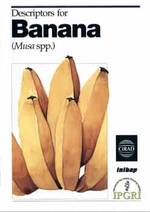 |
Descriptors for Banana (Musa spp.) (0.4 MB)
Authors: International Plant Genetic Resources Institute (IPGRI); International Network for Improvement of Banana and Plantain (INIBAP); French Agricultural Research Centre for International Development (CIRAD)
Publication Year: 1996
Pages: 55
ISBN-10: 92-9043-307-8
ISBN-13: 978-92-9043-307-1
Language: English-French-Spanish
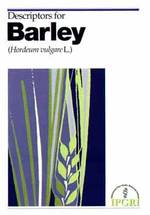 |
Descriptors for Barley (Hordeum vulgare L.) (1.2 MB)
This descriptor list provides an international format and thereby produces a universally understood 'language' for plant genetic resources data. The adoption of this scheme for data encoding will produce a rapid, reliable, and efficient means for information storage, retrieval, and communication, and will assist with the utilization of germplasm.
It is recommended, therefore, that information should be produced by closely following the descriptor list with regard to: ordering and numbering descriptors; using the descriptors specified; and using the descriptors states recommended.
Authors: International Plant Genetic Resources Institute (IPGRI)
Publication Year: 1994
Pages: 46
ISBN-10: 92-9043-222-5
ISBN-13: 978-92-9043-222-7
Language: English
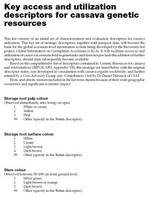 |
Key access and utilization descriptors for cassava genetic resources (0.1 MB)
This list consists of an initial set of characterization and evaluation descriptors for cassava utilization.
This key set of strategic descriptors, together with passport data, will become the basis for the global accession-level information system being developed by the Bioversity-led project, Global Information on Germplasm Accessions (GIGA). It will facilitate access to and utilization of cassava accessions held in genebanks and does not preclude the addition of further descriptors, should data subsequently become available.
Authors: Bioversity International, CIAT, IITA, EMBRAPA
Publication Year: 2009
Pages: 5
Language: English
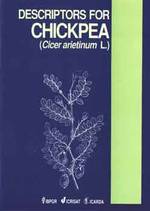 |
Descriptors for Chickpea (Cicer arietinum L.)(1 MB)
Published in cooperation with the International Center for Agricultural Research in the Dry Areas and the International Crops Research Institute for the Semi-Arid Tropics
Authors: International Board for Plant Genetic Resources (IBPGR); International Crops Research Institute for the Semi-Arid Tropics (ICRISAT); International Center for Agricultural Research in the Dry Areas (ICARDA)
Publication Year: 1999
Pages: 31
ISBN-10: 92-9043-137-7
ISBN-13: 978-92-9043-137-4
Language: English
 |
The Grass Descriptor List was initially developed by a sub-committee from the Commission of the European Communities' (CEC) Programme Committee for Plant Disease Resistance Breeding and the Use of Genebanks. The final list combines experience from National List Descriptors, UPOV (International Union for the Protection of New Varieties of Plants) Descriptor Lists and was produced with advice and according to the International Board for Plant Genetic Resources standard format.
Authors: International Board for Plant Genetic Resources (IBPGR); Commission of European Communities (CEC)
Publication Year: 1985
Pages: 30
Language: English
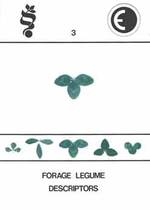 |
The Forage Legume Descriptors list was developed by a sub-committee, from the Commission of the European Communities’ (CEC) Programme Committee for Plant Disease Resistance Breeding and the use of Genebanks. The final list combines experience from National List Descriptors, UPOV Descriptor Lists and was produced with advice and according to the standard format of the International Board for Plant Genetic Resources (IBPGR).
Authors: International Board for Plant Genetic Resources (IBPGR); Commission of European Communities (CEC)
Publication Year: 1984
Pages: 24
Language: English
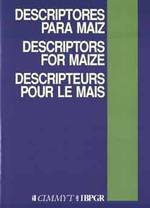 |
Descriptors for Maize (0.5 MB)
In 1980 IBPGR published a minimal list of descriptors for maize (Zea mays L.) following the third meeting of the IBPGR Maize Advisory Committee. This list was revised by IBPGR and CIMMYT in consultation with Cher experts (see Appendix). Descriptor numbers from the 1980 list were cross-referenced and are enclosed in parentheses following the descriptor in the revised list.
Authors: International Board for Plant Genetic Resources (IBPGR); International Maize and Wheat Improvement Center (CIMMYT)
Publication Year: 1991
Pages: 86
ISBN-10: 92-9043-189-X
ISBN-13: 978-92-9043-189-3
Language: English-Spanish-French
(see also: Key access and utilization descriptors for maize genetic resources, Bioversity International; International Maize and Wheat Improvement Center (CIMMYT), 2009. Click here to open this publication)
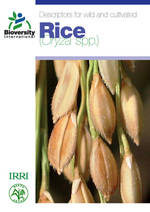 |
Descriptors for wild and cultivated Rice (Oryza spp.) (1.2 MB)
'Descriptors for wild and cultivated rice (Oryza spp.)' is a revision of the original IBPGR and IRRI publication 'Descriptors for rice (Oryza sativa L.)' (1980), expanded to include descriptors for wild rice species of the genus Oryza, and harmonized as far as possible with descriptors developed by the International Union for the Protection of New Varieties of Plants (UPOV 2004; www.upov.org) for new cultivars of cultivated rice.
Authors: Bioversity International; International Rice Research Institute (IRRI); Africa Rice Center (WARDA)
Publication Year: 2007
Pages: 63
ISBN-10: 92-9043-716-2
ISBN-13: 978-92-9043-716-1
Language: English, Spanish
See also: Key access and utilization descriptors for rice genetic resources, Bioversity International and International Rice Research Institute (IRRI), 2009. Click here to open this publication
 |
Descriptors for Wheat (Revised) (0.5 MB)
Authors: International Board for Plant Genetic Resources (IBPGR); Commission of the European Communities (CEC)
Publication Year: 1985
Pages: 12
Language: English
 |
Descriptors for Coconut (1.7 MB)
Authors: International Plant Genetic Resources Institute (IPGRI)
Publication Year: 1995
Pages: 61
ISBN-10: 92-9043-215-2
ISBN-13: 978-92-9043-215-9
Language: English
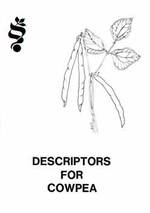 |
Descriptors for Cowpea (0.2 MB)
A coded list is given of descriptors and descriptor states for characterizing Vigna unguiculata cultivars in germplasm work. (Abstract © CAB ABSTRACTS, CAB International)
Authors: International Board for Plant Genetic Resources (IBPGR)
Publication Year: 1983
Pages: 29
Language: English
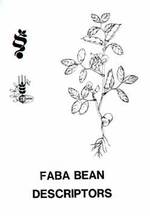 |
Descriptors for Faba bean (0.6 MB)
Authors: International Board for Plant Genetic Resources (IBPGR); International Center for Agricultural Research in the Dry Areas (ICARDA)
Publication Year: 1985
Pages: 19
Language: English
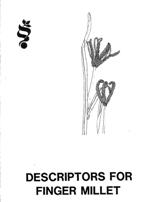 |
Descriptors for Finger millet (0.9 MB)
Authors: International Board for Plant Genetic Resources (IBPGR)
Publication Year: 1985
Pages: 20
Language: English
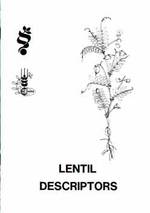 |
Descriptors for Lentil (1.7 MB)
Authors: International Board for Plant Genetic Resources (IBPGR); International Center for Agricultural Research in the Dry Areas (ICARDA)
Publication Year: 1985
Pages: 15
Language: English
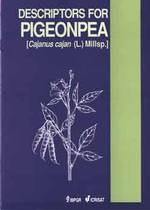 |
Descriptors for Pigeonpea (0.9 MB)
Published in cooperation with the International Crops Research Institute for the Semi-Arid Tropics
Authors: International Board for Plant Genetic Resources (IBPGR); International Crops Research Institute for the Semi-Arid Tropics (ICRISAT)
Publication Year: 1993
Pages: 31
ISBN-10: 92-9043-138-5
ISBN-13: 978-92-9043-138-1
Language: English
 |
Descriptors for pearl millet (1.2 MB)
Authors: International Board for Plant Genetic Resources (IBPGR); International Crops Research Institute for the Semi-Arid Tropics (ICRISAT)
Publication Year: 1993
Pages: 43
ISBN-10: 92-9043-136-9
ISBN-13: 978-92-9043-136-7
Language: English-French
See also: Key access and utilization descriptors for pearl millet genetic resources, Bioversity International, ICRISAT, USDA-NPGS, AICR. 2010. Click here to open this publication
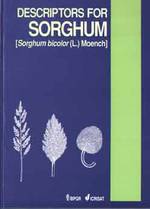 |
Descriptors for Sorghum (1.2 MB)
Authors: International Board for Plant Genetic Resources (IBPGR); International Crops Research Institute for the Semi-Arid Tropics (ICRISAT)
Publication Year: 1993
Pages: 38
ISBN-10: 92-9043-135-0
ISBN-13: 978-92-9043-135-0
Language: English-French
 |
Descriptors for Sweet potato (0.5 MB)
Authors: International Board for Plant Genetic Resources (IBPGR); International Potato Center (CIP); Asian Vegetable Research and Development Center (AVRDC)
Publication Year: 1991
Pages: 134
ISBN-10: 92-9043-204-7
ISBN-13: 978-92-9043-204-3
Language: English-Spanish-French
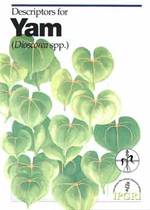 |
Descriptors for Yam (0.3 MB)
Authors: International Plant Genetic Resources Institute (IPGRI); International Institute of Tropical (IITA) Agriculture
Publication Year: 1997
Pages: 61
ISBN-10: 92-9043-353-1
ISBN-13: 978-92-9043-353-8
Language: English-Spanish-French
In vitro conservation and cryopreservation manuals
Refinement and standardization of storage procedures for clonal crops
The World Bank-funded Global Public Goods Phase II Project (GPG2) administered by the System Wide Genetic Resources Programme (SGRP) successfully promoted collective actions for the conservation of genetic resources held in the genebanks of the Consultative Group for Plant Genetic Resources (CGIAR). The remit of GPG2 is to increase the security, quality and risk management of genebanks through the development of best practices, validated methodologies and risk management procedures. As appropriate GPG2 outcomes support third party accreditation. Among the collective actions, collaborative activity: “Refinement and standardization of storage procedures for clonal crops” was given to the CGIAR’s In Vitro Genebanks, represented by the Clonal Crop Task Force (CCTF) composed of genetic resources research staff from the four centres: Bioversity International, CIAT, CIP and IITA. These hold the in trust collections of Musa, cassava, potato, sweetpotato, yam and Andean root and tuber crops (ARTCs). The overarching aims of this activity were to:
(1) review the status of vitro conservation in the context of the GPG2 project with an emphasis on the mandated clonal crops;
(2) survey the facilities, storage protocols and practices of CGIAR’s clonal crop genebanks;
(3) collate and review this information with a view to developing quality and risk management systems to support the production and validation of multi-crop best practice guidelines. Outputs from this activity are designated as a three part ‘trilogy’:
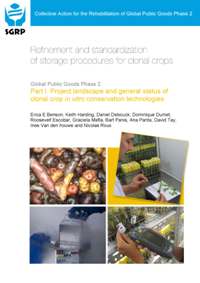 |
Part I, Project landscape and general status of clonal crop in vitro conservation technologies, introduces the GPG2 project within the CGIAR landscape and overviews the status of in vitro plant conservation in the wider conservation community of practice. This part describes the role of risk and quality management for the effective maintenance of in vitro genebanks in the context of research and the development and validation of best practices.
Authors: Erica E Benson, Keith Harding, Daniel Debouck, Dominique Dumet, Roosevelt Escobar, Graciela Mafla, Bart Panis, Ana Panta, David Tay, Ines Van den Houwe and Nicolas Roux
Reviewed by: Sarah E Ashmore and Barbara M Reed
Publication Year: 2011
Pages: 82
ISBN: 978-92-9043-905-9
Language: English
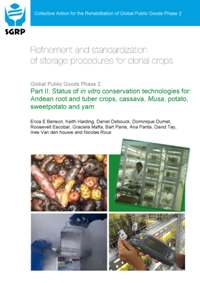 |
Part II, Status of in vitro conservation technologies for Andean root and tuber crops, cassava, Musa, potato, sweetpotato and yam, provides a status update on the mandate clonal crops. As tasked by GPG2, it includes lessons learnt, critical point analyses and the priority research needs of CGIAR’s in vitro genebanks.
Authors: Erica E Benson, Keith Harding, Daniel Debouck, Dominique Dumet, Roosevelt Escobar, Graciela Mafla, Bart Panis, Ana Panta, David Tay, Ines Van den Houwe and Nicolas Roux
Reviewed by: Joachim Keller and Florent Engelmann
Publication Year: 2011
Pages: 106
ISBN: 978-92-9043-906-6
Language: English
Please click here for full size PDF (9 MB)
 |
Part III, Multi-crop guidelines for developing in vitro conservation best practices for clonal crops, is a compilation of quality and risk management best practices and guidelines from both plant and other bioresources communities. This collective knowledge provided the foundation for developing the GPG2 multi-crop best practice guidelines. They are compiled in two parts. Section I comprises general operational guidelines for quality and risk management in in vitro plant genebanks. Section II provides generic, multi-crop technical guidelines for the medium-term (slow growth) and long-term (cryopreservation) storage of crop germplasm held in in vitro active genebanks (IVAGs) and in vitro base genebanks (IVBGs) respectively.
Authors: Erica E Benson, Keith Harding, Daniel Debouck, Dominique Dumet, Roosevelt Escobar, Graciela Mafla, Bart Panis, Ana Panta, David Tay, Ines Van den Houwe and Nicolas Roux
Reviewed by: David Galsworthy, Florent Engelmann and David Ellis
Publication Year: 2011
Pages: 144
ISBN: 978-92-9043-833-5
Language: English
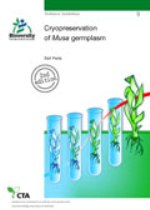 |
Technical Guidelines 9: Cryopreservation of Musa germplasm, 2nd edition (1.3MB)
The aim of this publication is to provide information and guidance on cryopreservation methodologies suitable for use on Musa germplasm. The different methods currently used at Katholieke Universiteit Leuven (KULeuven) for cryopreserving Musa cultures are described as well as the advantages and disadvantages of each of them. The areas where research is still required to further optimize the protocols are also identified. It is hoped that the detailed descriptions of the methodologies will facilitate their adoption and standard use in different laboratories.
Author: Panis, B. Edited by Erica Benson and Florent Engelmann
Publication Year: 2009
Pages: 51
ISBN: 978-2-910810-86-3
Language: English (also available in French and Spanish)
 |
Handbooks for Genebanks No. 7:
Technical guidelines for the management of field and in vitro germplasm collections
Plant species that are vegetatively propagated, that have long life cycles and/or produce nonorthodox seeds are traditionally maintained in field collections. Maintaining plants in the field is costly and carries high risks of loss; therefore, the strategies and procedures employed to establish and maintain field collections need to be practical, rational and economic, in addition to being scientifically sound. Experience in cost-effective management of field collections lies with individual curators and is not readily available to guide others. Further, there are increasing opportunities for using in vitro methods for the conservation of crops normally conserved in the field, and there is a need to develop strategies and procedures for managing in vitro collections as routine and integral part of the overall conservation strategy of a crop or collection.
Authors: Reed, B.M.; Engelmann, F.; Dulloo, M.E.; Engels, J.M.M.
Publication Year: 2004
Pages: 106
ISBN-10: 92-9043-640-9
ISBN-13: 978-92-9043-640-9
Language: English
 |
IPGRI Technical Bulletin No. 7: In vitro collecting techniques for germplasm conservation (0.6MB)
During the early 1980s, while searching for ways to more fully utilize the techniques of plant biotechnology, IPGRI (the International Plant Genetic Resources Institute, then the International Board of Plant Genetic Resources, IBPGR) suggested that germplasm be collected by means of in vitro methods. Between 1990 and today, research in this area has been performed by different groups, leading to the development and/or optimization of in vitro collecting techniques for various additional species including coconut, taro, tropical rainforest tree species and wild and endangered species.
This Technical Bulletin comprises three separate parts. The first part (theoretical background to in vitro collecting), consists of three chapters regarding the rationale behind the development of in vitro collecting and its potential for the conservation of crops and wild or endangered species and the control of contamination, a critically important step which conditions the successful development of any in vitro collecting protocol.
The second part (case studies) comprises nine chapters, each describing the work performed for the development of in vitro protocols for a particular species or group of species. The protocols described can be applied directly for collecting germplasm of any of the species concerned. However, circumstances will differ from one collecting mission to the next and it can be expected that these protocols will have to be adapted to these circumstances. Therefore, the aim of these chapters is to illustrate the range of protocols, from the simplest to the most sophisticated, which can be developed for in vitro collecting germplasm of a given species and to highlight the critical steps of such protocols. Such information should be used by the readers as a guide for the development of protocols for the species of their own interest.
The last part (prospects) consists of a single chapter which analyses the future of in vitro collecting for improving the conservation and use of plant genetic resources.
This Technical Bulletin includes references up to 2001. It includes both theoretical and practical aspects, aims to provide a resource for those wishing to understand the basic concepts of adapting plant tissue culture methods to field collecting.
Authors: Valerie C. Pence, V.C.; Sandoval, J.A.; Villalobos, V.M.; Engelmann, F. (eds.)
Publication Year: 2002
Pages: 100
ISBN-10: 92-9043-534-8
ISBN-13: 978-92-9043-534-1
Language: English
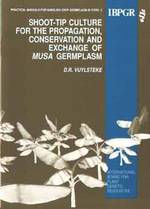 |
Practical manuals for Handling Crop Germplasm In Vitro 2:
Shoot-tip Culture for the Propagation, Conservation and Exchange of Musa Germplasm (This manual can be purchased via Bioversity's website here)
This publication reviews in detail the history of shoot-tip culture of Musa, in vitro propagation procedures, in vitro conservation, germplasm exchange using in vitro cultures and potential problems.
Authors: Vuylsteke, D.R.
Publication Year: 1989
Pages: 56
ISBN-10: 92-9043-140-7
ISBN-13: 978-92-9043-140-4
Language: English
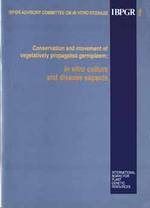 |
IBPGR Advisory Committee on In Vitro Storage: Report of a Subcommittee Meeting: Conservation and Movement of Vegetatively Propagated Germplasm: In Vitro Culture and Disease Aspects (Available in HTML version)
This report examines the problem and reviews the mid-1987 status of some major crops. It looks at the scope available for improvement, for example in in vitro transfer of germplasm and improved indexing, and makes recommendations for future action. Also included are eight reports outlining the status of a number of crops.
Authors: IBPGR
Publication Year: 1988
Pages: 60
ISBN-10: 92-9043-125-3
ISBN-13: 978-92-9043-125-1
Language: English
For more manuals on this topic, please visit the Bioversity International website here.
Germplasm collections
 |
Handbooks for Genebanks No. 6:
A guide to effective management of germplasm collections (1.4MB)
The initiative to bring experts together to discuss the consequences of changes in the roles and responsibilities of genebanks led to this publication. It is hopes that the ideas put forward lead to more critical balanced and creative approach towards genebank operations on the part of genebank curators worldwide. It is also hoped that decisions concerning concepts and strategies that have been or will be made at the institutional and national level on the conservation and use of plant genetic resources will be made easier by this publication. Genebank are encouraged to share their experiences through all means of communication. The reader is kindly invited to provide IPGRI with any comments or suggestions on the current text that would contribute to more effective and efficient conservation and thereby assist in the generation of a solid knowledge base for genebank management.
Authors: Engels, J.M.M.; Visser, L. (eds.)
Publication Year: 2003
Pages: 174
ISBN-10: 92-9043-582-8
ISBN-13: 978-92-9043-582-2
Language: English
 |
IPGRI Technical Bulletin No. 3: Core Collections of plant genetic resources (0.9MB)
Genebanks around the world hold collections of the genetic resources of crop plants for long-term conservation and for ease of access by plant breeders, researchers and other users. Perceiving that the large size of some collections could deter use, Frankel (1984) proposed that a limited or "core collection" could be established from an existing collection. With minimum similarity between its entries the core collection is of limited size and chosen to represent the genetic diversity of a large collection, a crop, a wild species or group of species. It does not replace the existing collection or material from which it is obtained. Core collections have become accepted as efficient tools for improving conservation and use of collections. The Global Plan of Action for the Conservation and Sustainable Utilization of Plant Genetic Resources for Food and Agriculture (FAO 1996) recommends core collection development as one of the activities needed to improve use of plant genetic resources. This technical bulletin sets out the procedures that can be used to establish, manage and use a core collection, drawing on the accumulated experience so far.
Authors: van Hintum, Th.J.L.; Brown, A.H.D.; Spillane, C.; Hodgkin, T.
Publication Year: 2000
Pages: 48
ISBN-10: 92-9043-454-6
ISBN-13: 978-92-9043-454-2
Language: English
 |
IPGRI Technical Bulletin No. 5: Accession management trials of genetic resources collections (0.7MB)
The publication is aimed at curators and other genebank staff. It is meant to be a discussion guide, to provide ideas and suggestions on how management procedures can be improved, and to point to possible implications of a given management procedure. It does not aim to provide a definitive theory on composing genebank collections or on the management of accessions, nor does it attempt to provide a complete overview of possible approaches and procedures. The reader is invited to give feedback to IPGRI (comments, additions, alternative approaches, etc.) on any aspect of the contents, and thus contribute to the discussion started with this publication.
Authors: Sackville Hamilton, N.R.; Engels, J.M.M.; van Hintum, Th.J.L.; Koo, B.; Smale, B.
Publication Year: 2002
Pages: 66
ISBN-10: 92-9043-516-X
ISBN-13: 978-92-9043-516-7
Language: English
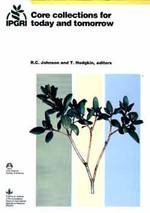 |
Access and management of germplasm collections: Core collections for today and tomorrow (available as HTML version)
Core collections offer a tool to improve access and management of germplasmcollections, and therefore are of great interest to those who use and manage plant genetic resources. Over the past few years, experience with core collection has increased as cores for many crops have been developed. The purpose of this publication is to review the current status of core collections and present examples of core development and utilization. The authors were chosen to report on a wide range of views and experiences with core collections, but the examples were not chosen based on desigantion by crop. We find few cores have actually been developed for the major seed crops. Ironically, the use of core collections to improve access to large, unwieldy collections, originally envisioned by Sir Otto Frankel, has not yet come to fruition. Certeinly the complexity and volume of data needed to develop a core collection for large collections can be daunting, but possible approaches and opportunity are described.
Authors: Johnson, R.C.; Hodgkin, T. (eds.)
Publication Year: 1999
Pages: 81
ISBN-10: 92-9043-424-4
ISBN-13: 978-92-9043-424-5
Language: English
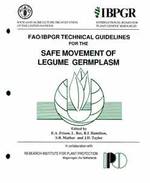 |
FAO / IBPGR Technical Guidelines for the Safe Movement of Legume Germplasm: A methodological model for ecogeographic surveys of crops (0.3MB)
These guidelines are divided into 2 parts. The first makes general recommendations on how best to move grain and fodder legume germplasm and breeding material. The second part covers the important viral, bacterial and fungal diseases of quarantine concern. The information given on any particular pathogen concentrates on those aspects most relevant to quarantine. An appendix lists Latin and vernacular (English, French, Spanish, German and other) names of major legume species. (Abstract © CAB ABSTRACTS, CAB International)
Authors: Frison, E.A.; Bos, L.; Hamilton, R.I.; Mathur, S.B.; Taylor, J.D. (eds.)
Publication Year: 1990
Pages: 88
ISBN-10: 92-9043-150-4
ISBN-13: 978-92-9043-150-3
Language: English



 Manuals and handbooks
Manuals and handbooks
